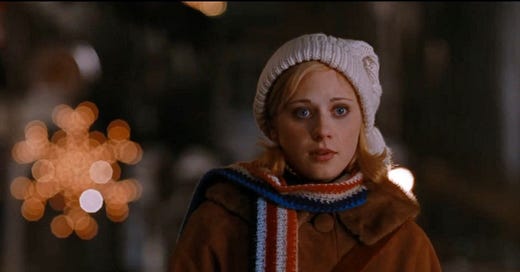If you’re new here, read this quick primer on the Story Energies, a new way to talk about storytelling.
Christmas is a story. There’s the ‘original’—Jesus is born in a stable, and visited by shepherds and kings—and there are various spin-offs and re-imaginings—families get together for some quality time, for example, or Santa delivers gifts to children who haven’t been naughty.
Even though the plots of these iterations are quite different, what unites them is a feeling of well-being and togetherness. A calm descends upon Bethlehem. Families (at least in theory) put aside their grievances to enjoy an elaborate stuffing. Santa delivers gifts to all nice children, all across the world.
That Christmas Spirit that unites these stories is about uniting (at least some) people. It’s something in the air, that we can share…
In my last post on the Netflix series Nobody Wants This, I wrote about the Electrical Energy generated by all the emotion in all those long exchanges between the two romantic leads. But as careful students of the Story Energies already know, while Electrical Energy can make our characters’ hearts pump faster, it can also crackle in the air around them, in the atmosphere of a story’s scenes.
We’re all familiar with the idea of atmosphere, but it can be a difficult one to define, exactly. My dictionary describes it as the envelope of gases surrounding the earth or another planet the pervading tone or mood of a place, situation, or creative work, and while tone and mood are similarly slippery concepts, let’s consider them for a moment:
Tone suggests the ways people are behaving.
Mood suggests the ways people feel.
And I think it’s true that, while we often imagine the atmosphere of a place to be distinct from the characters moving through it, most of the time it is in fact generated by those characters, collectively, and in a way that is unconscious or automatic.
A house can’t really feel haunted unless there’s someone paying attention to its creaking floors. Without people watching, a thunder storm is just weather.
An atmosphere is usually created by a group of people who are sharing an emotional experience, or who want the same thing. Like a crowd of mourners at a funeral, or a group of protesters at a political rally, or an angry mob hunting for a witch. Or a bunch of hippies staring up at the stars on a winter solstice. Or a gang of teenagers intoxicated by rule breaking. Or a staff of office workers at a Christmas party.
It is also true that we don’t need a crowd for the air to sizzle and spark. Ask the couple strolling through Paris all night until the street lamps turn off. Or one of that couple, a few months later, after they break up, alone in the desert gazing up at the same stars as the hippies, on that same winter night, confronted by the universe’s size and indifference.
But when we’re only talking about one or two or three people, it requires a lot from them to tremble the air. And it’s harder to separate out their emotions, inside their bodies, from the atmosphere they’re perceiving around them.
With a crowd, it’s easier for the atmosphere to at least seem like it is taking on a life of its own.
And, in fact, in some strange, hard-to-define way, it really can—people together can create an atmosphere, which can then influence them and also other people who wander by. So a mob can get all riled up and end up doing terrible things. Or, in a nicer and more seasonable example, we can all decide to take some time off work, buy and wrap gifts, and be nice to one another.
In keeping with this Christmas spirit, I have extended our Launch Party free trial offer—sign up today for 60 days of free, full access to all Story Energies content.
Most of you, I imagine, have seen Elf. And you’ll remember the scene when Santa’s sleigh’s not flying because the general levels of Christmas Spirit are too low, and Jovie (Zoe Deschanel) braces herself…
… and stands up and starts singing, and one-by-one the crowd of on-lookers joins in with her, as the needle on Santa’s Clausometer slowly starts to rise… Through her act of courage (especially as we know from earlier in the movie that she’s scared of singing in front of other people), she manages to transform the atmosphere outside New York’s Central Park (and in all the living rooms and bars watching on TV) from one of confusion and disquietude into one of togetherness and joy. And so she helps save Christmas.
Life, unfortunately, is seldom so sweet. But it is worth remembering that while many stories are shaped by the prevailing atmospheres of their times, some of the most compelling narratives feature characters who stand up, and raise their voices, and somehow manage to alter those atmospheres. And so, in turn, enact a huge change upon their societies.
For better or for worse—but today let’s think of some ‘for better’ examples, like Martin Luther King, Ruth Bader Ginsberg, Greta Thunberg, Malala Yousafzai…
As storytellers, an electric atmosphere can help captivate our audience, immerse them in our world, and sweep them along in the flow of our narrative. But given that it is, in essence, intangible, how can we generate a compelling atmosphere?
Keep reading with a 7-day free trial
Subscribe to The Story Energies to keep reading this post and get 7 days of free access to the full post archives.






